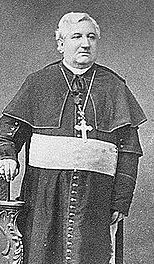Today, June 28th, is the anniversary of the death of Bishop St. Palais (Jacques-Maurice des Landes d’Aussac De Saint Palais) in 1877.
Bishop St. Palais is overlooked in many ways. Bishop Brute, of course, is remembered as that “saintly” bishop, the man who began the long and proud tradition of the Catholic Church in Indiana. Then Bishop de la Hailadiere, the one who is not held in so high esteem partly because of his relationships with his clergy, with St. Mother Theodore Guerin, and Fr. Sorin. I’ve written before of these things as well as Hailandiere’s qualities. Then there was Bishop Bazin, who began the healing, and who served such a short time.
Then comes St. Palais. Bishop for almost 30 years. He is the one who oversaw and guided the Church in Indiana through the largest growth ever seen up to that point. He is overshadowed in many  ways by Bishop Chatard, mainly because Chatard saw the relocation of the See to Indianapolis and the entrance into the 20th century. But, St. Palais was here when the growth first began and when the Church underwent some persecution and began to see a large influx of immigrants. Not only that, he was one of the “early” ones. He came to Indiana in 1836 with Bishop Brute. He saw the Church in Indiana grow from infancy to adulthood.
ways by Bishop Chatard, mainly because Chatard saw the relocation of the See to Indianapolis and the entrance into the 20th century. But, St. Palais was here when the growth first began and when the Church underwent some persecution and began to see a large influx of immigrants. Not only that, he was one of the “early” ones. He came to Indiana in 1836 with Bishop Brute. He saw the Church in Indiana grow from infancy to adulthood.
Born at LaSalvetat, France, November 15, 1811, he was ordained a priest at Paris on May 28, 1836. Shortly after his ordination he left with Bishop Brute, as mentioned above. He served in the village of Chicago and helped the Catholics in that city as they began their rapid growth. He was Administrator of the diocese of Vincennes after the death of Bishop Bazin and was named bishop on October 3, 1848. He was consecrated in the Cathedral at Vincennes on January 14, 1849, by Bishop Pius Miles, OP, of Nashville, assisted by Coadjutor Bishop Martin John Spalding of Louisville and Very Reverend Hippolyte Du Pontavice, vicar general of Vincennes. He died at St. Mary-of-the-Woods on June 28, 1877. That, I think, tells you something about his support of the Sisters. His body is interred in the Old Cathedral, Vincennes.
Here is an article which appeared in 1916 in the “Catholic World”, the organ of the Paulist Fathers. Louis P. Harl wrote:
Within ten years after the death of Bishop Brute, the Catholic population of the territory comprising the diocese of Vincennes had grown so rapidly that it had been found necessary in 1844 to separate Illinois from Indiana and create the new see of Chicago. Even with this loss, when Bishop de St. Palais took charge of the diocese of Vincennes it comprised thirty thousand souls, to care for whom there were only thirty-five priests. Quite different was the state of affairs when after forty-one years of fruitful labor, thirteen of which had been spent as a humble missionary priest and twenty-eight as the head of the see, Bishop de St. Palais died in 1877. At that time, despite the fact that the diocese had again been divided and the diocese of Fort Wayne established in the northern part of the State in 1857, there were in the diocese of Vincennes ninety thousand souls, one hundred and fifty-one churches and one hundred and seventeen priests, besides those included in the religious houses of the Franciscans, Benedictines, and the Congregation of the Holy Cross.